Mass spectrometer
a mass spectrometer and mass spectrometer technology, applied in mass spectrometers, separation processes, dispersed particle separation, etc., can solve the problems of air evacuation, troublesome and costly operation, and prone to increase in machining costs, so as to reduce kinetic energy, the effect of high degree of accuracy and efficient sending
- Summary
- Abstract
- Description
- Claims
- Application Information
AI Technical Summary
Benefits of technology
Problems solved by technology
Method used
Image
Examples
Embodiment Construction
[0028]With reference to FIGS. 1 to 3, a mass spectrometer according to one embodiment of the present invention will now be described. Except that an ion optical system to be disposed in the intermediate vacuum chamber 18 in FIG. 6 is different from that in FIG. 6, a fundamental structure of the mass spectrometer according to this embodiment is the same as that illustrated in FIG. 6. The difference will be specifically described below.
[0029]FIG. 1 is a schematic diagram showing an ion optical system 40 serving as a second lens electrode in the mass spectrometer according to this embodiment, viewed from the side of an ion incident end of the ion optical system. FIG. 2 is a sectional view taken along the line A-A′ in FIG. 1, and FIG. 3 is a fragmentary assembling diagram of the ion optical system.
[0030]The ion optical system 40 in this embodiment comprises four electrodes 41a, 41b, 41c, 41d each formed of a metal plate member having a given shape. Each of the electrodes 41a, 41b, 41c, ...
PUM
 Login to View More
Login to View More Abstract
Description
Claims
Application Information
 Login to View More
Login to View More - R&D
- Intellectual Property
- Life Sciences
- Materials
- Tech Scout
- Unparalleled Data Quality
- Higher Quality Content
- 60% Fewer Hallucinations
Browse by: Latest US Patents, China's latest patents, Technical Efficacy Thesaurus, Application Domain, Technology Topic, Popular Technical Reports.
© 2025 PatSnap. All rights reserved.Legal|Privacy policy|Modern Slavery Act Transparency Statement|Sitemap|About US| Contact US: help@patsnap.com



